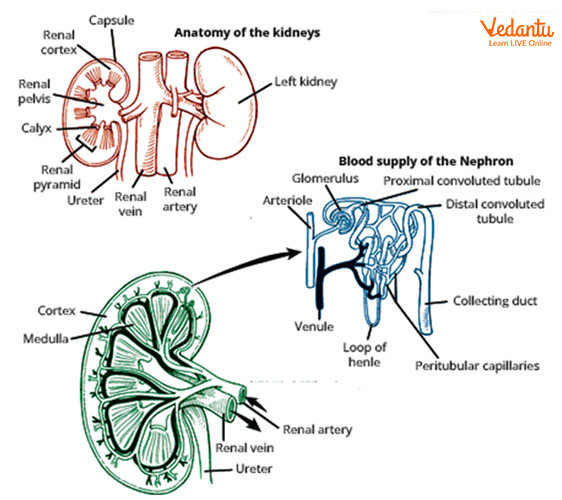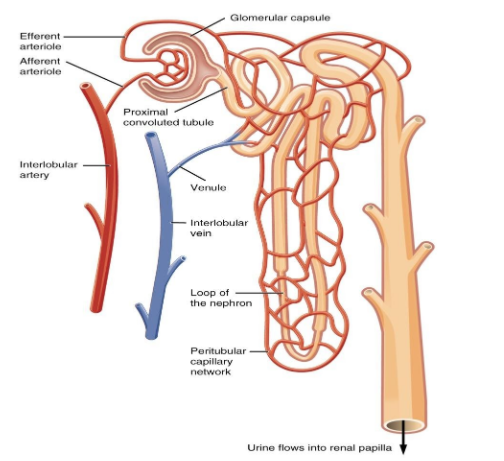Structure and Function of Nephron: The Kidney’s Main Unit Explained
The kidneys are a vital part of the human excretory system, responsible for filtering blood, removing waste products, and regulating fluid and electrolyte balance. Each kidney is a bean-shaped organ located just below and behind the liver in the peritoneal cavity. On top of each kidney sits an adrenal (suprarenal) gland. The kidneys continuously filter all of the body's blood throughout the day, helping to purify it and maintain homeostasis.
Structure of the Human Kidney
The human kidney is externally protected by three main layers. The outermost layer is the renal fascia, a tough connective tissue that provides support. Inside the fascia lies the perirenal fat capsule, which anchors the kidneys and offers cushioning. The innermost covering is the renal capsule, closely attached to the kidney's surface.

Internally, the kidney consists of three main regions:
-
Renal Cortex: The outermost region, granular in appearance due to millions of nephrons.
-
Renal Medulla: Located beneath the cortex, composed of several cone-shaped renal pyramids. The tips (renal papillae) point inward toward the renal pelvis.
-
Renal Pelvis: A funnel-shaped cavity in the center, which collects urine and leads to the ureter.
Renal pyramids and their adjoining cortex form units called kidney lobes. Between the pyramids are renal columns, which provide space for blood vessels and nerves. The renal pelvis branches into major calyces, and each major calyx divides into minor calyces, which collect urine from different pyramids.
| Part | Description | Function |
|---|---|---|
| Renal Cortex | Outer, granular layer | Contains most of the nephrons |
| Renal Medulla | Middle, striped region | Formed by renal pyramids; concentration of urine |
| Renal Pelvis | Central funnel-shaped cavity | Collects urine, channels to ureter |
| Major & Minor Calyces | Cup-like extensions of the pelvis | Collect urine from the pyramids |
| Renal Columns | Regions between pyramids | Pathway for blood vessels and nerves |
Blood Supply and Filtration
An extensive network of blood vessels enters the kidney at the hilum. The renal artery branches to segmental, interlobar, arcuate, and cortical radiate arteries, supplying blood to the nephrons. The renal vein carries filtered blood away. The arrangement of these vessels supports efficient filtration of blood and removal of waste.
The Nephron: Structural and Functional Unit
Each kidney contains over one million nephrons, the microscopic units that filter blood and form urine. Nephrons are found mainly in the cortex, but extend into the medulla. There are two nephron types: cortical (deep in cortex, about 85%) and juxtamedullary (near medulla, about 15%).

The main parts of a nephron are:
-
Renal Corpuscle: Located in the cortex, formed by the glomerulus (capillary network) and Bowman’s (glomerular) capsule.
-
Renal Tubule: Emerges from the corpuscle, divided into:
-
Proximal Convoluted Tubule (PCT): Closest to glomerulus, remains in cortex.
-
Loop of Henle: Forms a U-shaped loop descending into the medulla, then returns to the cortex.
-
Distal Convoluted Tubule (DCT): Located in cortex, connects to collecting duct.
-
-
Collecting Duct: Receives filtrate from multiple nephrons, descends through medullary pyramids, empties into the renal pelvis.
| Nephron Part | Main Function |
|---|---|
| Glomerulus | Filtration of blood plasma |
| Bowman's Capsule | Collects the filtrate |
| Proximal Convoluted Tubule | Reabsorption of water, glucose, and ions |
| Loop of Henle | Concentrates urine; reabsorbs water and salts |
| Distal Convoluted Tubule | Selective secretion and absorption; pH regulation |
| Collecting Duct | Final concentration of urine |
Capillary Networks Associated with the Nephron
Blood enters each nephron via an afferent arteriole, forms the glomerular capillary bed, and exits via the efferent arteriole. The efferent arteriole then creates a network called the peritubular capillaries (in cortical nephrons) or the vasa recta (around the loop of Henle in juxtamedullary nephrons). These vessels play a key role in reabsorption and secretion during urine formation.
Significance and Functions of the Kidney
The kidneys maintain body fluid balance, filter metabolic wastes, regulate electrolytes, and contribute to acid-base balance. They also support blood pressure control through specialized hormones and help in producing active vitamin D. Efficient kidney function is indispensable for overall health and well-being.
Practice Questions and Deeper Learning
-
Draw and label a simple kidney diagram and explain the function of each region.
-
Describe the stepwise path of blood flow through the kidney.
-
Explain the difference between cortical and juxtamedullary nephrons.
If you wish to learn about kidney disorders such as renal calculi. Explore related topics including nephron function, for further learning.


FAQs on Structure of Kidney: Parts, Functions, and Labeled Diagram
1. What is the structure and function of the kidney?
The kidney is a bean-shaped organ with a layered structure and multiple essential functions:
- Renal Cortex (outer layer): Contains most nephrons for blood filtration.
- Renal Medulla (inner region): Contains pyramids with loops of Henle and collecting ducts.
- Renal Pelvis: Funnel-shaped cavity that collects and transports urine to the ureter.
Functions include:
- Filtration of blood to remove wastes
- Regulation of fluid, electrolyte, and pH balance
- Blood pressure maintenance
- Hormone secretion (erythropoietin, renin)
2. What is nephron and its parts?
The nephron is the structural and functional unit of the kidney. Each nephron consists of:
- Bowman's capsule and glomerulus: Filtration of blood
- Proximal convoluted tubule (PCT): Reabsorption of water, ions, and nutrients
- Loop of Henle: Concentration of urine via counter-current system
- Distal convoluted tubule (DCT): Secretion and further reabsorption, pH regulation
- Collecting duct: Final water reabsorption, transport urine to renal pelvis
3. Which is the main unit of kidney?
The nephron is the main structural and functional unit of the kidney. Each kidney has about 1 million nephrons that filter blood, reabsorb necessary substances, and form urine. This ensures waste removal and homeostasis in the body.
4. What are the 7 functions of the kidney?
The kidneys have 7 major functions:
- Filtration – Removes metabolic waste from blood
- Fluid and electrolyte balance
- Acid-base (pH) regulation
- Osmoregulation – Controls water balance
- Excretion – Removes drugs and toxins
- Hormone secretion (erythropoietin, renin)
- Blood pressure regulation
5. How can I remember the structure of kidney diagram for exams?
To remember the kidney diagram for exams:
- Practice labeling kidney diagrams (cortex, medulla, pelvis, pyramid, calyces, ureter).
- Use mnemonics, e.g., "Clever Monkeys Play Piano Calmly Under Night" for Cortex, Medulla, Pelvis, Pyramid, Calyces, Ureter, Nephron.
- Revise regularly via flashcards and drawing exercises.
6. What is the difference between renal cortex and renal medulla?
Renal cortex and renal medulla are two distinct regions of the kidney:
- Renal cortex: The outer, lighter region containing the majority of nephrons and blood vessels.
- Renal medulla: The inner, darker region made up of renal pyramids and collecting ducts, concentrating urine before it moves to the pelvis.
7. What are the warning signs of kidney disease?
Common warning signs of kidney disease include:
- Swelling in the ankles, feet, or hands (edema)
- Fatigue or persistent weakness
- Changes in urine color, frequency, or amount
- Persistent itching, shortness of breath, or high blood pressure
8. What is the role of kidneys in homeostasis?
The kidneys play a vital role in maintaining homeostasis by:
- Regulating water and electrolyte balance
- Removing wastes and toxins
- Maintaining blood pH
- Controlling blood pressure and volume via hormone secretion
9. Name the blood vessels associated with the kidney and nephron.
Key blood vessels of the kidney and nephron include:
- Renal artery: Brings blood to the kidney
- Afferent arteriole: Supplies blood to the glomerulus
- Glomerular capillaries: Site of filtration
- Efferent arteriole: Carries blood away from the glomerulus
- Peritubular capillaries/vasa recta: Surround nephron tubules for exchange
- Renal vein: Drains filtered blood away from kidney
10. What is the function of the Loop of Henle?
The Loop of Henle concentrates urine and conserves water:
- Descending limb: Reabsorbs water, making filtrate more concentrated.
- Ascending limb: Reabsorbs salts (Na+, Cl-), making filtrate less concentrated.
- Creates a counter-current multiplier system essential for urine concentration.
11. What happens if both kidneys fail?
If both kidneys fail (kidney failure or end-stage renal disease):
- Wastes and fluids accumulate in the body
- Severe electrolyte and pH imbalance occurs
- Life-threatening complications can develop without treatment like dialysis or transplantation
12. What is the renal pelvis and its role?
The renal pelvis is the funnel-shaped cavity inside the kidney:
- Collects urine from the renal pyramids and calyces
- Channels urine into the ureter for transport to the urinary bladder










